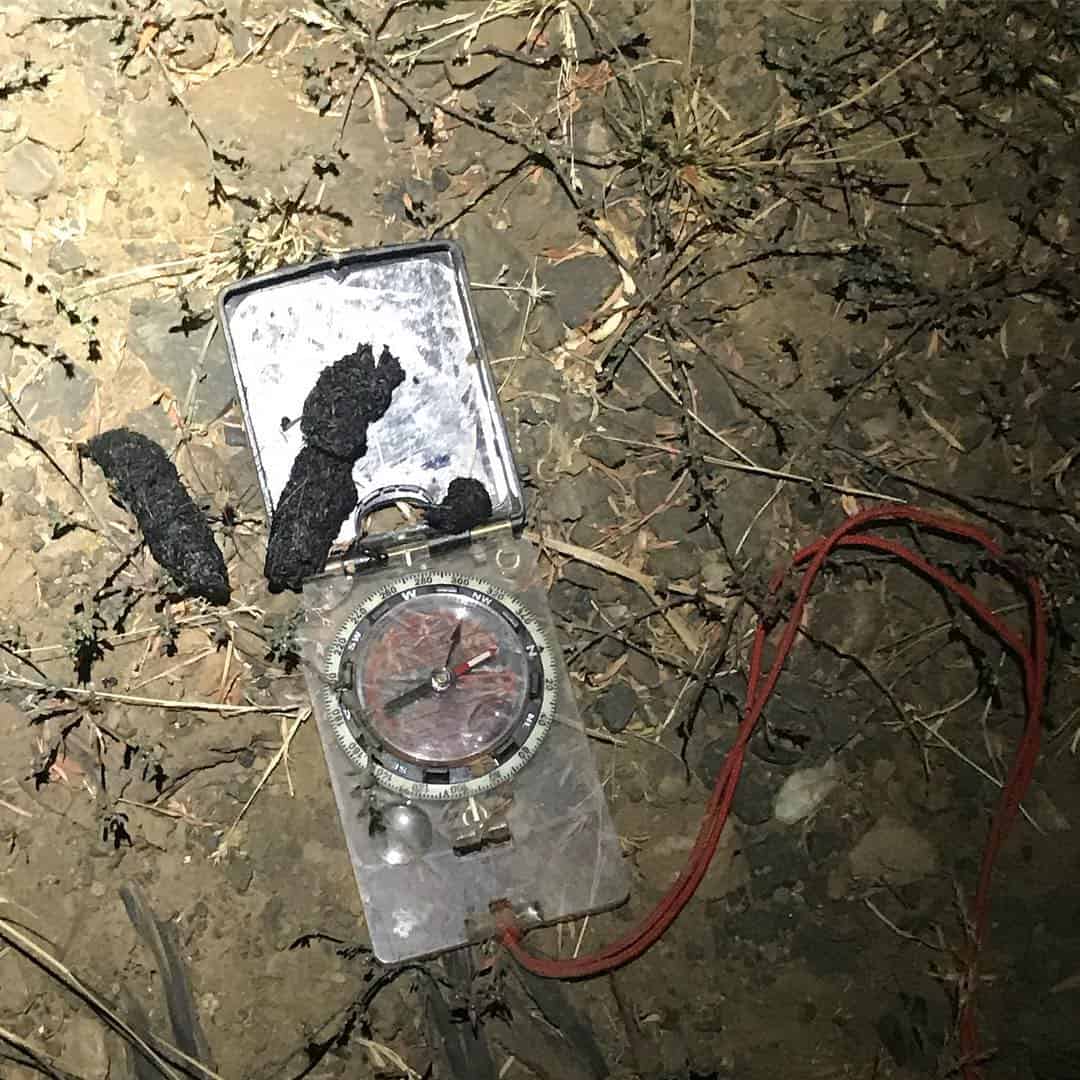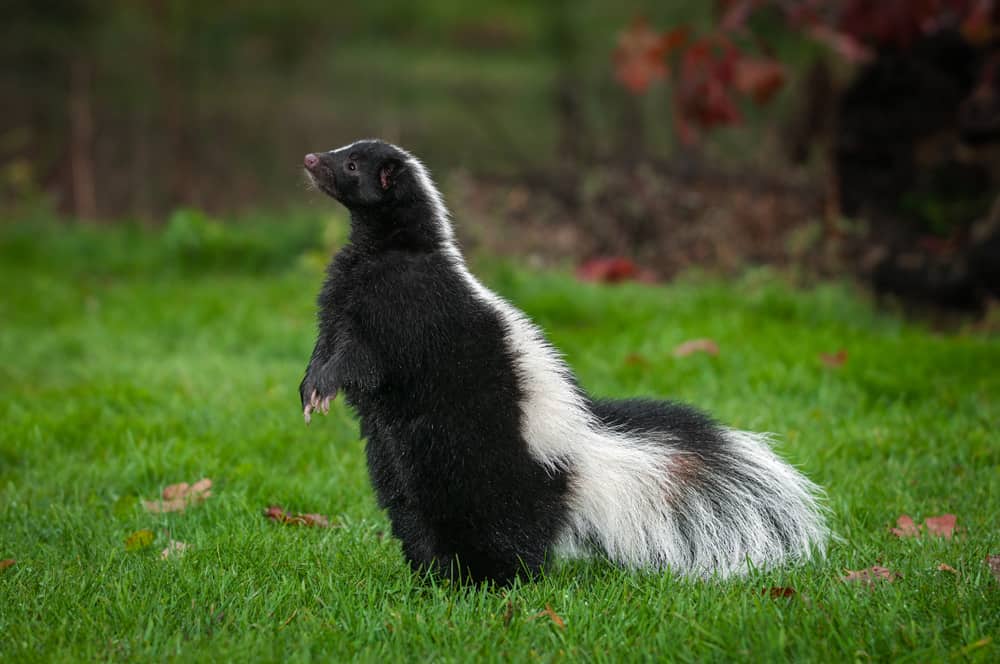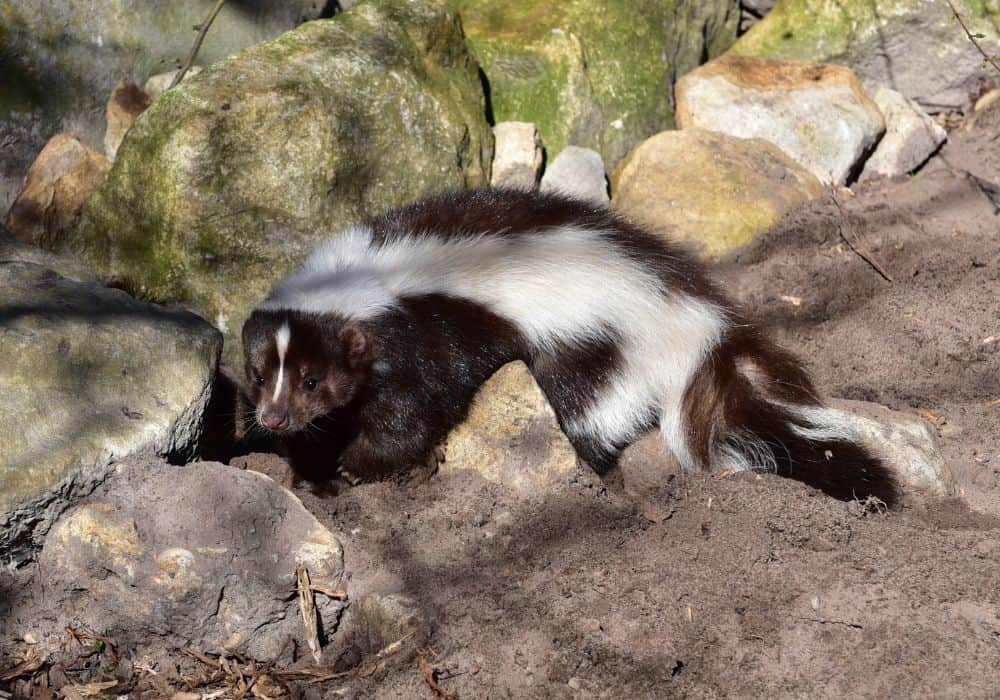It can be alarming when you come across a mysterious, smelly pile of poop in your yard, not knowing what type of animal left such a mess. Based on the odor, could it have been a skunk?
Most of us are familiar with the distinct odor of skunk spray, but not as familiar with what their droppings look like. However, Understanding skunk droppings can help protect your home, garden, and family from potential health risks and damage caused by these animals.
In this guide, we will discuss what skunk poop looks like, how it differs from other animal droppings and the possible health concerns associated with coming into contact with it.
How to Know a Skunk Poop
1. Shape
Skunks are lined with smooth muscles that contract and relax to move the waste. This results in their poo being tubular with blunt ends and almost the same size. They can be quite similar to cats, but skunk poo is usually longer and thicker.
2. Color
Skunk poop is usually black or dark brown. However, the exact shade of the poop can vary depending on the skunk’s diet. If the skunk has been consuming lots of berries, the poop may be darker than when it consumes insects and lizards. You could also notice other colors from undigested seeds, fur, grass, and feathers.
3. Size
The length of skunk poop can vary, depending on several factors, including the size of the skunk, the amount of waste produced, and the skunk’s breed.
The length is usually around 1 to 2 inches (2.5 to 5 cm). Adults have longer poo than smaller skunks. The size also makes it easier to differentiate from raccoon poo. Raccoons usually have longer waste at about 7.5cm.
4. Odor
A skunk odor is one of the major reasons why they are not as accepted in our environments as raccoons are.
Skunk feces has a strong, unpleasant odor that can be difficult to control. This odor results from the chemicals and bacteria produced in the skunk’s intestines during digestion. The odor is usually a defense mechanism, but their poop is no different. The odor can even be more powerful if the skunk consumes foods high in sulfur, such as garlic or onions.

5. Location
Skunk feces are typically found near burrows, den sites, or anywhere they can find food. They are omnivores and will feed on anything from fruits, smaller animals, and waste. So, their feces may be found in various locations, including gardens, lawns, forests, fields, and near homes or buildings.
What Should you Do when you see Skunk Poop?
Skunks are wild animals that carry a lot of bacteria that can be dangerous to you and your pets. Touching their droppings cause diseases like. Listeriosis – also known as ‘brain fever, Hepatitis which affects the kidneys, lungs, liver, and spleen, and rabies which can be lethal to people if not treated quickly. As a result, you should exercise caution when around skunks or their droppings.
The strong odor of skunk spray may also be present in skunk poop, which can be unpleasant and difficult to remove from clothing and other materials. The smell can also attract other wildlife, such as raccoons or coyotes, to the area, putting your health and safety at risk.
Your next action when you see a skunk poop in your yard is to try getting rid of it and disinfecting the area. A professional would be best for the job because they clean the area, identify any skunk territory close to you, and can set some preventive measures to keep them away from your home.
We’ll take a look at some of these cleaning and preventive methods below.
How To Get rid of Skunk Poop
To remove skunk droppings, follow these steps:
- Wear gloves and a mask to protect yourself from potential diseases and strong odors.
- Using a shovel or similar tool, carefully scoop the feces into a plastic bag. Picking up the droppings and any other solid debris.
- Use a paper towel or cloth to absorb any remaining moisture or residue.
- Apply an enzymatic cleaner or a mixture of water and vinegar to the affected area to neutralize any remaining odor.
- Dispose of the waste and wash your hands thoroughly with soap and water. The bag should be disposed of properly, either by burying it or placing it in the trash. Do not compost skunk feces, as it may contain parasites that can survive in the compost pile.
- Repeat the cleaning process as needed until the area is fully clean and odor-free.
This cleaning method should keep you safe and get rid of skunk poop odor. However, it can also be stressful having to do this every day. Preventing skunks from coming around your home is the best solution, and here are some tricks we recommend
Preventing Skunks from Your Home
1. Install motion-activated light
Since skunks are nocturnal and are attracted to dark and quiet areas, installing lights in your yard can make it less attractive to skunks. This will also help you spot any skunks that enter your yard, giving you a chance to take action before they cause any problems.
2. Use Automated Sprinklers
Skunks are not fond of water, and typically avoid areas where they are likely to get wet. Install motion-triggered sprinklers to activate when a skunk approaches. This creates a barrier that will deter skunks from entering your property.
Strategically position the motion sprinklers near spots where skunks may want to hide or look for food, like under your patio or in a window well. The sudden burst of water will startle the skunks and make them think twice about returning.
Motion-activated sprinklers are easy to install and maintain. They require no wiring or plumbing and can be set up with minimal effort.
3. Keep Your Yard Clean
This doesn’t mean you have to have a pristine lawn, but rather that you should remove any potential food sources for the skunks. This includes piles of logs, overgrown grass, and wild planting. All these things can attract insects which are a favorite snack for skunks.
You should also trim back bushes and trees so that there are no dark corners or crevices where they can take shelter. Keep the grass short and tidy up any debris or clutter in the yard, as this can provide an inviting home for skunks.
4. Keep Your Trash Can Sealed
A full trashcan or compost pile is like a buffet offering to skunks, so keep your garbage in a container with a tight lid if you can. Consider adding weight to the lid to keep it from being knocked over and keep kitchen scraps out of your compost pile. That’ll help keep skunks away. Feed Away from your home.
5. Remove Bird Feeds
Feeding the birds is a wonderful thing, but it can lead to a bit of a mess. Get rid of any birdseed you find lying around before it gets dark to avoid an unwanted visit from a skunk. If the cleanup is too much for you, take the feeder down till you don’t have a skunk problem.
6. Feed Pets Indoors
Feeding pets outdoors can encourage skunks and other wild animals to come near your home, increasing the chances of having their poo in your yard daily. Therefore, we suggest feeding your pet indoors, and if you must feed them outside, clean up remnants for your pets. Doing so removes a potential food source from your property, thus limiting skunks’ incentive to come close.
7. Use Ammonia-soaked Rags as a Repellant
The strong smell of ammonia does not appeal to these animals, and you can use it to your advantage by dipping small cloths into a mixture of ammonia and water and placing them around your property. However, ammonia evaporates quickly, so the effect lasts only one day, and the rags must be replaced the following day.
Some people have also reported success with strong scents like soaps and citrus sprays. While wildlife experts do not prove these solutions, they may act as makeshift solutions if you do not want to use other methods.
If all else fails, contact a professional to trap and release the skunk away from your property.
Conclusion
Skunk poop is easily recognizable with its strong odor and long black droppings, usually containing undigested feed. Knowing what it looks like can help you identify skunks in your area and protect your property from potential damage or mess.
If you spot some near your home and you’re worried a skunk has taken up residence, remember to take the actions below.
- Skunk feces are typically dark and tubular, with a distinct, strong odor.
- Ensure to practice safe removal techniques if you find skunk poop on your property; it could contain some nasty parasites,
- Clean the area thoroughly with a disinfectant solution after removing the feces.
- Dispose of the feces properly by burying it or placing it in a sealed plastic bag in the trash.
- Contact a local wildlife expert to discuss your options for safe pest removal.
If you have questions or concerns about skunks’ presence on your property, please feel free to comment below.

